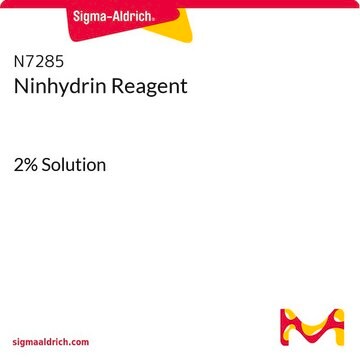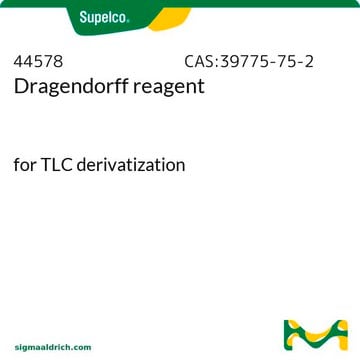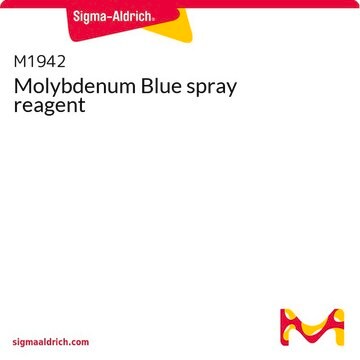N0507
Ninhydrin spray reagent
0.2% in ethanol
Synonym(s):
Ninhydrin solution
Sign Into View Organizational & Contract Pricing
All Photos(1)
About This Item
Empirical Formula (Hill Notation):
C9H6O4
CAS Number:
Molecular Weight:
178.14
MDL number:
UNSPSC Code:
12352100
PubChem Substance ID:
Recommended Products
form
liquid
Quality Level
concentration
0.2% in ethanol
storage temp.
2-8°C
SMILES string
OC1(O)C(=O)c2ccccc2C1=O
InChI
1S/C9H6O4/c10-7-5-3-1-2-4-6(5)8(11)9(7,12)13/h1-4,12-13H
InChI key
FEMOMIGRRWSMCU-UHFFFAOYSA-N
Looking for similar products? Visit Product Comparison Guide
Application
amino acids, amines and amino sugars.
replaced by
Product No.
Description
Pricing
Certificates of Analysis (COA)
Search for Certificates of Analysis (COA) by entering the products Lot/Batch Number. Lot and Batch Numbers can be found on a product’s label following the words ‘Lot’ or ‘Batch’.
Already Own This Product?
Find documentation for the products that you have recently purchased in the Document Library.
Matthew G Romei et al.
Science (New York, N.Y.), 367(6473), 76-79 (2020-01-04)
Rotation around a specific bond after photoexcitation is central to vision and emerging opportunities in optogenetics, super-resolution microscopy, and photoactive molecular devices. Competing roles for steric and electrostatic effects that govern bond-specific photoisomerization have been widely discussed, the latter originating
Yu-Feng Xie et al.
Journal of neurochemistry, 122(3), 605-618 (2012-05-23)
Neurons located in the trigeminal subnucleus caudalis (Vc) play crucial roles in pain and sensorimotor functions in the orofacial region. Because of many anatomical and functional similarities with the spinal dorsal horn (SDH), Vc has been termed the medullary dorsal
Chao Li et al.
Journal of biomaterials science. Polymer edition, 23(1-4), 405-424 (2011-02-12)
Biomaterials have been playing important roles in cartilage regeneration. Although many scaffolds have been reported to enhance cartilage regeneration, none of the scaffolds available are optimal regarding mechanical properties, integration with host cartilage and providing proper micro-environment for chondrocyte attachment
Mendel Friedman
Journal of agricultural and food chemistry, 52(3), 385-406 (2004-02-05)
The reaction of ninhydrin with primary amino groups to form the purple dye now called Ruhemann's purple (RP) was discovered by Siegfried Ruhemann in 1910. In addition, imines such as pipecolic acid and proline, the guanidino group of arginine, the
Darren B Hansen et al.
Chemical Society reviews, 34(5), 408-417 (2005-04-27)
Following its discovery by Siegfried Ruhemann in 1910, ninhydrin rapidly became a practical analytical tool. In 1954 it was found to be an important reagent to develop fingerprints on porous surfaces. Since its use in forensic chemistry, many efforts have
Our team of scientists has experience in all areas of research including Life Science, Material Science, Chemical Synthesis, Chromatography, Analytical and many others.
Contact Technical Service







